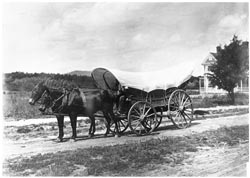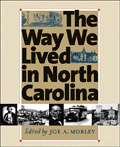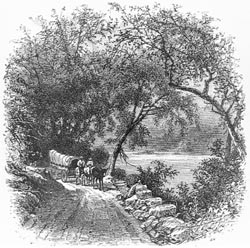
Conestoga wagon. These wagons were developed in Conestoga, Pennsylvania, to transport settlers and their possessions over the rough trails to their new homes in the wilderness. The slightly up-curved ends prevented the shifting of loads going up and down hills, and the canvas hood protected the passengers from the elements.
|



THE GREAT WAGON ROAD . . .
CHAPTER EXCERPTS
 fter 1735, as the supply of land grew short in colonies farther north, numerous farmers from Pennsylvania, Maryland, and Virginia began packing their possessions and making the long journey to the North Carolina Piedmont. At first the migrants were predominantly Scotch-Irish. Then, in the mid-1700s, Pennsylvania Germans joined their neighbors on the tedious trek. As newcomers flocked southward, the population of the North Carolina backcountry grew at an unprecedented rate. The path to Carolina came to be called the Great Wagon Road. "The country," wrote colonist Nathaniel Rice in 1752, "is in a flourishing condition, the western parts settling very fast." fter 1735, as the supply of land grew short in colonies farther north, numerous farmers from Pennsylvania, Maryland, and Virginia began packing their possessions and making the long journey to the North Carolina Piedmont. At first the migrants were predominantly Scotch-Irish. Then, in the mid-1700s, Pennsylvania Germans joined their neighbors on the tedious trek. As newcomers flocked southward, the population of the North Carolina backcountry grew at an unprecedented rate. The path to Carolina came to be called the Great Wagon Road. "The country," wrote colonist Nathaniel Rice in 1752, "is in a flourishing condition, the western parts settling very fast."
The diverse backgrounds of the immigrants shaped the North Carolina backcountry into a patchwork of religious and cultural enclaves. Many newcomers from Pennsylvania were Quakers. Newly arrived German families were predominantly Lutheran, with the notable exception of the Moravians. Immigrants of Scotch heritage were almost invariably Presbyterian. In addition, the Great Awakening, a tremendous religious revival that swept the English colonies in the mid-eighteenth century, resulted in the founding of several Baptist churches in the Carolina backcountry.

A wagon road.
|
Most of the early Scotch-Irish arrivals in America landed at Philadelphia and set up farms in Pennsylvania and Maryland. As these lands filled, some had to take up land in Virginia. In addition, the Scotch-Irish soon encountered competition from German immigrants (who, coming from "Deutschland," were incorrectly labeled as "Pennsylvania Dutch"). Indeed, wrote one English observer, the Scotch-Irish, "not succeeding so well in Pennsylvania as the more frugal and industrious Germans, sell their lands in that province to the latter, and take up new ground in the remote counties in Virginia, Maryland, and North Carolina." Many of the Scotch-Irish who moved to North Carolina were actually the younger children of immigrants who had settled land in Pennsylvania in earlier years. By the 1730s there was simply not enough land to go around; by 1735 the Scotch-Irish had begun entering North Carolina in significant numbers. They would continue to do so until the American Revolution.
During the mid-eighteenth century, Pennsylvania Germans began joining the Scotch-Irish on the long journey down the Great Wagon Road to North Carolina. For several decades after the settlement of New Bern in 1710, few Germans had entered the colony. But, by 1748, Germans too were being forced southward by the shortage of land in Pennsylvania.
Unique among the German settlements was the Moravian community that grew up on the Wachovia Tract in present-day Forsyth County. The United Brethren, often called the Moravians, originated in fifteenth-century Bohemia, the region we know today as the Czech Republic.
This first Moravian settlement is now an archeological park near present-day Winston-Salem. Although a few eighteenth-century buildings have survived intact, the ruins of many structures have been excavated and stabilized. Here visitors can see the foundation of the original Brothers' House, the first building constructed in Bethabara.

With the creation of a larger, more commercial Moravian settlement at nearby Salem in the 1760s and 1770s, another "God's Acre" would be created. "It is our opinion," declared the Moravians about establishing Salem, "that Bethabara should be a farming community, not a commercial center, as otherwise there is a danger that building and growth there might stand in the way of the new town. . . . Furthermore, it was determined by lot that we are to let our Brethren and Sisters in America know that the Saviour wills that Salem is to be the place in Wachovia for commerce and the professions, and they are to be moved thither from Bethabara." For over two centuries, deceased members of the Salem congregation have been brought to "God's Acre" from the church in town, accompanied by a small brass band, and laid to rest on the hillside. Each departed Moravian is buried not in a family plot, but among the choir members with whom they lived and worked: single men, single women, married men, or married women.
|

